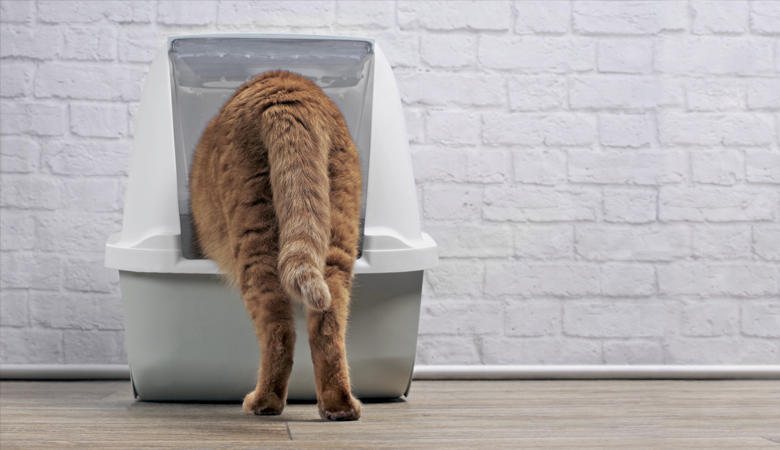Diarrhoea in cats and dogs
Written by Carmen |
Diarrhoea is a condition that most pet owners have to deal with at some point. There are two identifiable types of diarrhoea: diarrhoea of the large intestine or diarrhoea of the small intestine. In this article, you can read all about the various forms, causes and treatments of diarrhoea infections in your pet.

Diarrhoea
If there is a problem with the intake of nutrients in the small intestine or of water in the large intestine, this leads to diarrhoea. This is why there are two types of diarrhoea: of the large intestine and of the small intestine. If your pet also appears generally unwell aside from having diarrhoea (fever, lethargy, poor appetite) or vomits, it is always a good idea to contact your veterinarian. This also applies when you have a young or old pet, or if the diarrhoea continues for more than 3 days, and of course if you have any doubts or feel like your pet may be dehydrated.
Diarrhoea of the large intestine
In diarrhoea of the large intestine, the frequency of defecation is much higher than usual and animals often strain and show an increased urge to poop. Small amounts of loose stools tend to be produced each time, sometimes accompanied by mucous and/or blood. When walking your pet, they will often defecate multiple times, or will keep trying because the swelling maintains the feeling that it needs to poop. If your pet continues to strain, it is sensible to go to your veterinarian, because this can be highly intrusive.
Diarrhoea of the small intestine
In the event of diarrhoea of the small intestine, the following symptoms are often observed: lots of bubbling in your pet’s stomach, lots of farting, loose “watery poop”, needing to go out more often but not to extreme levels. Defecating just once during a walk, but much more than usual. Causes of diarrhoea of the small intestine often involve worm infestations (such as Giardia), bacteria and viruses. Irritation of the bowel as a result of the intake of certain substance is also possible, and this can include a change in your pet’s diet, the wrong food (for your pet) or something that your pet has eaten off the street.
Worms
If you cannot rule out a worm infestation, you need to give your cat or dog worming treatment to ensure that it has regular faecal examinations. It is recommended that you give your pet (preventive) worming treatment around 4x a year, or create a tailored schedule based on faecal examinations. (Young) animals often suffer from roundworms or tapeworms and all of our worming products are highly effective against these. It is important that you set the dosage based on your pet’s weight (if you do not know how much your pet weighs, weigh them first). Depending on the product of your choice, you will need to administer the treatment once or for several consecutive days.
Giardia
These days, problems caused by Giardia (in both cats and dogs) are increasingly common. This can be combated with Panacur or Metronidazole, while following a special treatment schedule. Hygiene is a key factor when it comes to Giardia. The environment and the animal itself can easily contain Giardia oocysts (eggs), making re-infestation easy. This is why it is a good idea to treat all pets at the same time. The animal can be washed with a mild shampoo. The area can be treated with products such as Dettol. The area should be cleaned with an ammonium solution and the pillows and blankets can often be machine washed.
Viruses
Viruses can often be the cause of diarrhoea as well. Most animals are vaccinated against the most common viruses (parvo, canine distemper, cat flu). I would disregard cat flu in this context, as it has nothing to do with diarrhoea. Unfortunately, not all viruses can be vaccinated against, meaning that they remain a common cause of diarrhoea. Not much can be done against viruses, so you can only fight the diarrhoea “symptom”.
Bacteria
Bacteria in the gut can cause diarrhoea because they do not belong in the intestines or because the healthy balance has been disrupted. If this happens, the bacteria that are normally present can increase in number (or reduce in number), which can also lead to diarrhoea. Sometimes antibiotics are needed and sometimes it’s enough to restore the balance with the help of supplements such as Bene Bac Plus and Canikur pro. You can also use products such as Finidiar or AA Diarstop to stop or reduce the diarrhoea.
What you can do to treat acute diarrhoea at home
You can give your pet a supplement that thickens the stool or that catches the harmful substances. Most supplements will also provide extra vitamins and minerals, as your pet is not taking in nutrients as effectively with a disrupted bowel function. These products include Iso-gel, Diarsanyl or Finidiar.
It is also important for your pet to continue to drink plenty of fluids, because they are losing more than they usually would through their stools.
Nutrients
Many people immediately stop feeding their pet for 24 hours, but that’s not always the best solution. Your pet needs nutrients, because it is losing more of them through its stools. This is why we recommend that you give your pet several small meals a day, using their normal food or moving to an easily digestible food such as Royal Canin Gastro Intestinal Low Fat and Royal Canin Gastro Intestinal
If the diarrhoea persists, if your pet stops eating or if it shows other symptoms of illness, don’t wait too long to contact your veterinarian.



